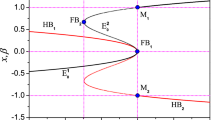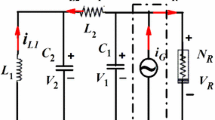Abstract
The main purpose of the paper is to reveal the mechanism of certain special phenomena in bursting oscillations such as the sudden increase of the spiking amplitude. When multiple equilibrium points coexist in a dynamical system, several types of stable attractors via different bifurcations from these points may be observed with the variation of parameters, which may interact with each other to form other types of bifurcations. Here we take the modified van der Pol–Duffing system as an example, in which periodic parametric excitation is introduced. When the exciting frequency is far less than the natural frequency, bursting oscillations may appear. By regarding the exciting term as a slow-varying parameter, the number of the equilibrium branches in the fast generalized autonomous subsystem varies from one to five with the variation of the slow-varying parameter. The equilibrium branches may undergo different types of bifurcations, such as Hopf and pitchfork bifurcations. The limit cycles, including the cycles via Hopf bifurcations and the cycles near the homo-clinic orbit, may interact with each other to form the fold limit cycle bifurcations. With the increase of the exciting amplitude, different stable attractors and bifurcations of the generalized autonomous fast subsystem involve the full system, leading to different types of bursting oscillations. Fold limit cycle bifurcations may cause the sudden change of the spiking amplitude, since at the bifurcation points, the trajectory may oscillate according to different stable limit cycles with obviously different amplitudes. At the pitchfork bifurcation point, two possible jumping ways may result in two coexisted asymmetric bursting attractors, which may expand in the phase space to interact with each other to form an enlarged symmetric bursting attractor with doubled period. The inertia of the movement along the stable equilibrium may cause the trajectory to pass across the related bifurcations, leading to the delay effect of the bifurcations. Not only the large exciting amplitude, but also the large value of the exciting frequency may increase inertia of the movement, since in both the two cases, the change rate of the slow-varying parameter may increase. Therefore, a relative small exciting frequency may be taken in order to show the possible influence of all the equilibrium branches and their bifurcations on the dynamics of the full system.











Similar content being viewed by others
Data availability
The datasets generated during and/or analysed during the current study are available from the corresponding author on reasonable request.
References
Vanag, V.K., Zhabotinsky, A.M., Epstein, I.R.: Pattern formation in the Belousov-Zhabotinsky reaction with photochemical global feedback. J. Phys. Chem. A 104, 11566–11577 (2000)
Aslanov, V.S., Ledkov, A.S.: Dynamics of Tethered Satellite Systems. Woodhead Publishing, Sawston, Cambridge (2012)
Fenichel, N.: Persistence and smoothness of invariant manifolds for flows. Indiana Univ. Math. J. 21, 193–226 (1971)
Fenichel, N.: Geometric singular perturbation theory for ordinary differential equations. J. Differ. Equ. 31, 53–98 (1979)
Rinzel, J.: Bursting oscillations in an excitable membrane model. In: Sleeman, B.D., Jarvis, R.J. (eds.) Ordinary and partial differential equations, pp. 304–316. Springer, Heidelberg (1985)
Izhikevich, E.M.: Neural excitability, spiking and bursting. Int. J. Bif. Chaos 10, 1171–1266 (2000)
Shen, J.H., Zhou, Z.Y.: Fast-slow dynamics in first-order initial value problems with slowly varying parameters and application to a harvested logistic model. Commun. Nonlinear Sci. Numer. Simul. 19, 2624–2631 (2014)
Cymbalyuk, G.S., Gaudry, Q., Masino, M.A., Calabrese, R.L.: Bursting in leech heart interneurons: cell-autonomous and network-based mechanisms. J. Neurosci. 22, 10580–10592 (2002)
Zhang, F., Lu, Q.S., Duan, L.X.: Dynamics analysis and transition mechanism of bursting calcium oscillations in non-excitable cells. Chinese Phys. Lett. 24, 3344–3346 (2007)
Kingni, S.T., Keuninckx, L., Woafo, P., Van der Sande, G., Danckaert, J.: Dissipative chaos, Shilnikov chaos and bursting oscillations in a three-dimensional autonomous system: theory and electronic implementation. Nonlinear Dyn. 73, 1111–1123 (2013)
Bertram, R., Rubin, J.E.: Multi-timescale systems and fast-slow analysis. Math. Biosci. 287, 105–121 (2017)
Zhang, H., Chen, D.Y., Wu, C.Z., Wang, X.Y.: Dynamics analysis of the fast-slow hydro-turbine governing system with different time-scale coupling. Commun. Nonlinear Sci. Numer. Simul. 54, 136–147 (2018)
Zhang, X.F., Chen, Z.Y., Bi, Q.S.: Analysis of bursting phenomena in Chens system with periodic excitation. Acta Phy. Sin-Ch. Ed. 59, 3802–3809 (2010)
Han, X.J., Bi, Q.S.: Bursting oscillations in duffings equation with slowly changing external forcing. Commun. Nonlinear Sci. Numer. Simul. 16, 4146–4152 (2011)
Li, Z.J., Li, Y., Ma, M.L., Wang, M.J.: Delayed transcritical bifurcation induced mixed bursting in a modified SM system with asymmetrically distributed equilibria. Braz. J. Phys. 51, 840–849 (2021)
Li, X.H., Tang, J.H., Wang, Y.L., Shen, Y.J.: Approximate analytical solution in slow-fast system based on modified multi-scale method. Appl. Math. Mech-Engl. 41, 605–622 (2020)
Wen, Z.H., Li, Z.J., Li, X.: Bursting oscillations and bifurcation mechanism in memristor-based Shimizu-Morioka system with two time scales. Chaos Solitons Fractals 128, 58–70 (2019)
Han, X.J., Xia, F.B., Ji, P., Bi, Q.S., Kurths, J.: Hopf-bifurcation-delay-induced bursting patterns in a modified circuit system. Commun. Nonlinear Sci. Numer. Simul. 36, 517–527 (2016)
Zhang, Z.D., Chen, Z.Y., Bi, Q.S.: Modified slow-fast analysis method for slow-fast dynamical systems with two scales in frequency domain. Theor. Appl. Mech. Lett. 9, 358–362 (2019)
Matouk, A.E., Agiza, H.N.: Bifurcations, chaos and synchronization in ADVP circuit with parallel resistor. J. Math. Anal. Appl. 341, 259–269 (2008)
King, G.P., Gaito, S.T.: Bistable chaos. I. Unfolding the cusp. Phy. Rev. A 46, 3092–3099 (1992)
Braga, D.D., Mello, L.F., Messias, M.: Bifurcation analysis of a van der Pol-Duffing circuit with parallel resistor. Math. Probl. Eng. 2009, 149563 (2009)
Yang, Z.Y., Jiang, T., Jing, Z.J.: Bifurcations and chaos of Duffing-van der Pol equation with nonsymmetric nonlinear restoring and two external forcing terms. Int. J. Bif. Chaos 24, 1430011 (2014)
Cui, J.F., Zhang, W.Y., Liu, Z., Sun, J.L.: On the limit cycles, period-doubling, and quasi-periodic solutions of the forced van der Pol-Duffing oscillator. Numer. Algorithms 78, 1217–1231 (2018)
Xu, Y.Y., Luo, A.C.J.: Independent period-2 motions to chaos in a van der Pol-Duffing oscillator. Int. J. Bif. Chaos 30, 2030045 (2020)
Ji, J.C., Zhang, N.: Nonlinear response of a forced van der Pol-Duffing oscillator at non-resonant bifurcations of codimension two. Chaos Solitons Fractals 41, 1467–1475 (2009)
Chow, S.N., Hale, J.K.: Method of Bifurcation Theory. Springer-Varlag, New York (1982)
Kuznetsov, Y.A.: Elements of Applied Bifurcation Theory. Springer-Verlag, New York (1997)
Acknowledgements
The work is supported by the National Natural Science Foundation of China (Grant Nos. 11872188,11632008).
Author information
Authors and Affiliations
Corresponding author
Ethics declarations
Conflict of interest
No conflict of interest exits in the submission of this manuscript, and manuscript is approved by all authors for publication. I would like to declare on behalf of my co-authors that the work described was original research that has not been published previously, and not under consideration for publication elsewhere, in whole or in part. All the authors listed have approved the manuscript that is enclosed.
Additional information
Publisher's Note
Springer Nature remains neutral with regard to jurisdictional claims in published maps and institutional affiliations.
Rights and permissions
About this article
Cite this article
Zhang, X., Zhang, B., Han, X. et al. On occurrence of sudden increase of spiking amplitude via fold limit cycle bifurcation in a modified Van der Pol–Duffing system with slow-varying periodic excitation. Nonlinear Dyn 108, 2097–2114 (2022). https://doi.org/10.1007/s11071-022-07309-6
Received:
Accepted:
Published:
Issue Date:
DOI: https://doi.org/10.1007/s11071-022-07309-6




